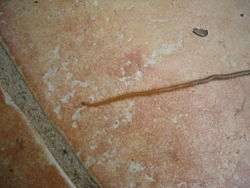Himantarium gabrielis
Himantarium gabrielis is a species of centipede in the family Himantariidae.[1]
| Himantarium gabrielis | |
|---|---|
 | |
| Himantarium gabrielis | |
| Scientific classification | |
| Kingdom: | |
| Phylum: | |
| Class: | |
| Order: | |
| Family: | |
| Genus: | |
| Species: | H. gabrielis |
| Binomial name | |
| Himantarium gabrielis (Linnaeus, 1767) | |
Synonyms
- Himantarium algericus Brandt (1841)
- Himantarium ambiguus Brandt J.F. (1841)
- Himantarium broelemanni Léger & Duboscq 1903
- Himantarium dubius Brandt (1841)
- Himantarium hispanicum Meinert 1870
- Himantarium hova Saussure & Zehntner 1902
- Himantarium laevigatus Brullé (1832)
- Himantarium lefevrei Lucas in Guérin-Méneville (1840)
- Himantarium longissimus Risso (1826)
- Himantarium rubrovittatus Lucas (1846)
- Himantarium rugulosus C.L. Koch (1841)
- Himantarium savignyanus Gervais (1837)
- Himantarium semipedalis Dufour (1820)
- Himantarium sulcatus Brullé (1832)
- Himantarium viridipes Brandt (1841)
- Himantarium walckenaeri Gervais (1835)
- Himantarium xanthinus Newport (1845)
Description
Himantarium gabrielis can reach a length around 13–22 cm (5.1–8.7 in).The head is small and lacks eyes, but has two tentacles with 14 segments. On the dorsal side of the last trunk segment are longitudinal and transversal wide sulci resembling a cross. The body is yellowish to orange in colour and has up to 179 segments, with a pair of legs each. The number of legs is very variable, usually leg-bearing segments vary from 87 to 179 in males and from 95 to 171 in females.[4]
When disturbed, this species emits viscous and proteinaceous secretions from the sternal glands.[5] It feeds on various invertebrates. It can be found under stones or in galleries into the ground.[6] The females protect their eggs with the body until the hatching of their young.[7]
Distribution
This species is widely distributed in the Mediterranean region. It can be found in Albania, Bosnia, Bulgaria, Croatia, France, Greece, Italy, North Macedonia, Portugal, Romania, Slovenia, and Switzerland.[8]
References
- Biolib
- ChiloBase: A World Catalogue of Centipedes (Chilopoda) for the web
- Catalogue of life
- Stylianos Michail Simaiakis Relationship between intraspecific variation in segment number and geographic distribution of Himantarium gabrielis (Linné, 1767) (Chilopoda: Geophilomorpha) in Southern Europe
- Vujisić, LV; Vučković, IM; Makarov, SE; Ilić, BS; Antić, DZ; Jadranin, MB; Todorović, NM; Mrkić, IV; Vajs, VE; Lučić, LR; Curčić, BP; Mitić, BM (2013). "Chemistry of the sternal gland secretion of the Mediterranean centipede Himantarium gabrielis (Linnaeus, 1767) (Chilopoda: Geophilomorpha: Himantariidae)". Naturwissenschaften. 100: 861–70. doi:10.1007/s00114-013-1086-6. PMID 23907296.
- Animalandia
- Ville Natura
- Fauna europaea
Further reading
- Linnaeus C. "Systema Naturae per regna tria nature, secundum classes, ordines, genera, species, cum characteribus, differentiis, synonymis, locis. Editio duodecima, reformata" Holmiae. 1767: 533-1327, see p. 1063.
- Minelli A., Bonato L. (2006) "European geophilomorph centipedes (Chilopoda: Geophilomorpha): a complete synonymical list with taxonomic and nomenclatural notes"